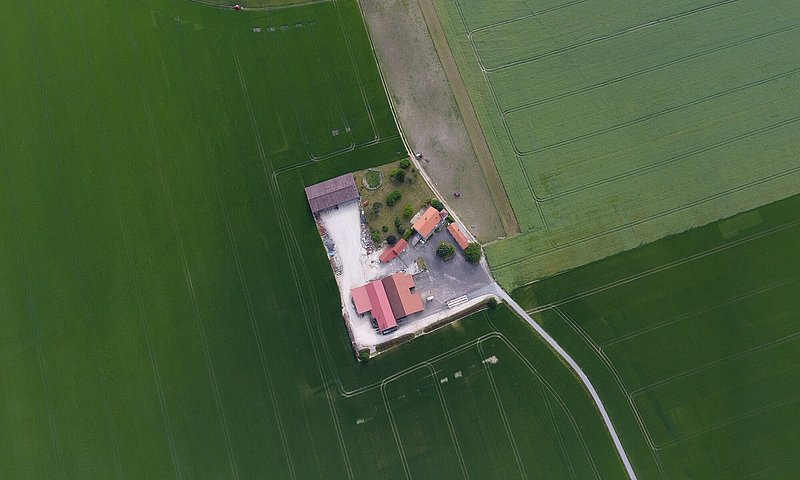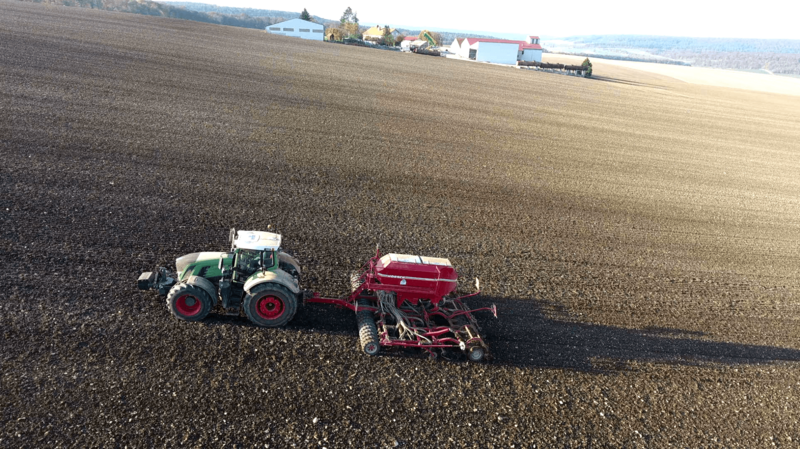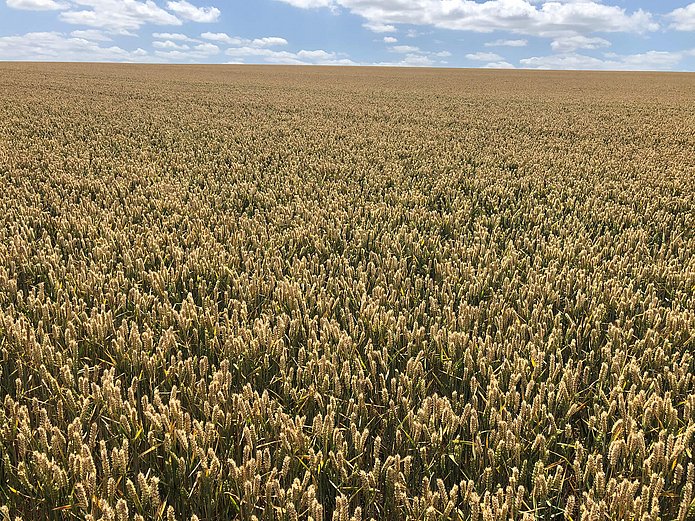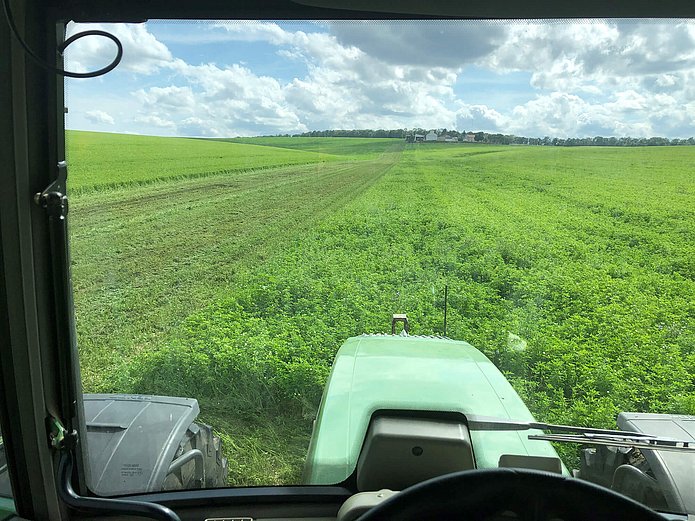
Focus on the future
On Jean-Luc Didier’s farm everything is centred around one objective: the radical reduction of production costs. Since 2005 a HORSCH Sprinter ST has been the key machine in his cultivation system. “This had not been clear in the first place. I was rather sceptical“, the farmer says. For terraHORSCH he describes his approach.
Jean-Luc Didier runs a farm in the department Haute-Marne in France. His way of farming is very pragmatical. He works with the methods he thinks are best for his farm – without dogmatically insisting on his methods being the only correct ones. His individual system is based on own tests and cannot not always be transferred – especially not to soils with high potential.
His farm consists of two farmsteads which are 50 km apart. The climate conditions are similar. Both farmsteads have grain silos and bunker silos. The fields are quite a long way from each other. The soils, however, differ widely. 65 % of the arable land are located at the high plain of Barrois with more or less stones. The depth of the soils varies from 10 cm to 30 cm and the share of stones can partly amount to more than 50 %. 25 % are drained, wet clay soils and the remaining 10 % are healthy, silty clay soils. Some of them consist of 60 % clay, some of them are very stony. With regard to rainfall there partly is a difference of 200 mm between the two sites. The average rainfall amounts to 950 mm per year and mainly falls in autumn and winter. Jean-Luc Didier is not only a farmer, but also a contractor.
“My conditions are far from ideal“, Jean-Luc Didier says. “Especially because some fields are very steep – there is an altitude difference of up to 100 m – and because the recurrent climate imponderabilities of the past years have an enormous influence on the yields and on the quality of the products. To give you an idea: In 2019, there was a three-month drought in France. In autumn, however it rained a lot: 392 mm in three months!”
Conversion
Jean-Luc Didier took over the farm in 1995. Because of the high amount of stones and the clayey soils as well as for reasons of work efficiency the farm has been working exclusively with a no-till system without a plough for 49 years, i.e. since 1971. In 2005 he increased the cultivated land by 75 %. To make this step profitable the machinery had to be reorganised. “There were many types of machines that existed twice on the farm, e.g. one 4-meter rotary harrow and a 6-meter one, one 6-meter and one 8-meter seed drill – four seed drills in total. It was evident that there was potential for savings. I sold 34 machines and bought 17 machines, some of them second-hand.“
At that time the farm manager still relied on intensive farming and grew crops that were typical for the region: rape, winter barley, winter wheat. Machine costs were calculated tightly, without unnecessary investments – but also without affecting the sowing quality.
“I was looking for a 6-meter seed drill that performs excellently on different soils – quick and without having to change the settings all the time. In fact, it was to carry out the work of four machines – with regard to quality and versatility – and at the same time guarantee the same seed placement quality in wet soils as a rotary harrow. And by no means did I want to take a loss in yields. Last but not least, the operating costs were to be similar to those of our old Nodet seed drill. But at that time there was no seed drill on the market that was able to meet all my requirements.
In 2005, I was not yet a HORSCH customer. I was not interested in the Seed Exactor. I thought that it was too complicated. In my opinion, it was an energy guzzler without enough throughput capacity. Neither was I a typical Airseeder CO customer, at that time the concept did not seem very promising to me. I liked the tine sowing system, but at the Airseeder the tines were mounted at a double spring with a lot of moving parts. When the Sprinter ST was launched it could at least meet one of my requirements: to keep the acquisition costs and the operating costs as low as possible, especially due to the FlexGrip system. But I was still not completely convinced. When Michael Horsch explained to me that a lot Airseeders CO had been sold to Great Britain and that the customers over there achieved wheat yields of 10 ton per ha, my decision was clear. My cultivation system changed completely. With my new machinery I only needed 1.9 hp per hectare (plant protection included) – although my fields were a long way away from each other and despite the steep slopes.“
Doubting the versatility of the Sprinter
At first, the restructuring of the agronomic system and of the machinery was a leap in the dark for Jean Luc Didier. „I was sceptical because I had to replace a seed drill with a rotary harrow which was always a solution when anything else did no longer work. You could sow in the most difficult conditions. And to be on the safe side I kept my other 4-meter seed drill for one year – just in case.” The farmer loves to tell this anecdote: “I once sowed wheat after sunflowers at the beginning of November. In very wet conditions. The window when it did not rain was extremely tight. To be able to sow with the tractor with twin tyres I lifted the front part of the seed drill to prevent the tractor from sliding on the slopes. I kept up the operational speed of 15 km/h. After all, I had to sow 60 hectares in one day! When the crops emerged and even during the harvest, I noticed that the result was absolutely identical compared to the rotary harrow-seed drill combination.

I also noticed that if with the Sprinter you keep up a high speed and break the earth constantly the bottom of the furrow does not get compacted and the water permeability of the furrow and the humidity absorption of the plant is encouraged. So I also sold the last rotary harrow that still existed on my farm.“
An economic seed drill
“The Sprinter ST is very economic – for several reasons. First, it is a tine seed drill. I think that tines wear off less quickly than discs. The tines are rigid and thus less prone to wear. And the tyres of the new models are large enough to carry the chassis. Thus, you do not have to replace them at an inopportune time.
At my first model I only replaced the wedge-shaped plate after 6,000 hectares. And at the new models only the setting angle of the tine had to be changed, the tine itself did not have to be replaced at all.
I now already have the third Sprinter. I sold the first one because I wanted to have a double hopper and to observe the road traffic regulations and the second one to meet the brake standards and because of the only disadvantage the seed drill had: the horsepower requirement. My current Sprinter is equipped with two tines less – that’s an important factor to reduce the horsepower requirement. Today my average diesel consumption amounts to 7 litres per hectare when I sow with a Duett point“, Jean Luc Didier explains.
To meet the new stipulations with regard to sowing the Duett points were replaced by narrower points that move less earth and therefore require less horsepower.
Beside the mere technical aspect that makes the machine this economical with regard to maintenance and diesel consumption, the Sprinter also shows its advantages when it comes to working hours and logistics. “The machine is easy to adjust and solid. This is why even a temporary worker quickly gets used to is. You only have to insert the depth stops to adjust the inclination of the machine and the seed depth.“ As the stipulated dimensions for road transport are observed he saves time when he has to cover large distances. He neither needs a vehicle that goes ahead nor an additional employee. The large capacity of the hoppers that amounts to 5,000 litres reduces the number of return journeys to the farm. “We, therefore, also had to reorganise our working hours as we suddenly were able to sow more hectares – with less machines and less staff. I also appreciate the large tyres of our Sprinter“, the farmer explains.
New questions
At that time, the main reason for using the Sprinter was simple: to get an even, consolidated seedbed. Today there are completely new problems: The machine also has to be able to work in plant residues and catch crops.
“For five years I have been well aware of the fact that there is a change with regard to the public perception of our profession. We are under an enormous social pressure, get more and more new environmental regulations and have additional problems like soil contamination, insect pests and the loss of certain active agents which are not replaced by an alternative. Among them for example glyphosate. One or two years ago I was convinced that it would still be tolerated in conservation farming. At least as long as there is a new active agent. Thus, there are many factors that influenced my decisions with regard to new production systems and that tipped the scales to strike a new direction. In our region, with our climate conditions and the extremely dry soils we are heading towards extensive farming – at least in my opinion. And this is the model I finally went for.“
According to Jean-Luc Didier this also requires to grow “exotic“ crops: “Though they are not necessarily in line with our soil climatic conditions, they are indispensable for an extensive concept. Peas are not adapted to stony soils. Oats, linseed and sunflowers react in a hypersensitive way to drought. Maize does not like stones or stagnant water in spring an autumn. Soya is afraid of drought in summer and can only be harvested late in autumn. But every plant plays its role with regard to the “hygiene“ of the fields and the balance of the soils. You can continue to cultivate rape even if it is an intensive crop. But it has to be part of a wide rotation that includes spring crops. At the moment, I am growing rape, soya, spring peas, linseed, sunflowers, winter and spring wheat, winter and spring barley. In the future we will have to be prepared to lose some money on the individual crops – especially with regard to yields – but if you consider all elements of the rotation it might be compensated for.”
An extensive cultivation system, thus, is the logical consequence for the farmer whose arable concept is completely aimed at a drastic reduction of the costs. As the maximum limit of the yields has been reached and they no longer are the main factor for economic efficiency of a farm – except for at present in the organic sector – the only lever that can still influence the farm profits is the production costs. “Because of the extreme weather conditions, it becomes more and more difficult to hope for high yields. When you have gone through several challenging years, you simply have to think things over. With regard to the use of plant protection agents, too, we have reached a dead end. A reduction will be forced upon us. This is why I want to get my fields clean without depending on herbicides. In my opinion, a cultivation system with a wide rotation and conventional seeding or no-till farming is the best solution on our limey clay soils with low potential.”
Sprinter ST in an extensive system
Jean-Luc Didier works a lot with catch crops and green manure plants. He relies on high-protein plants, hairy vetch, Ethiopian mustard, phacelia and – in case you have problems with the soil structure – on field beans.
“After harvesting, the crops are sown with a Sprinter ST – directly into the straw stubbles. Especially on very stony soils. This is why I purchased new narrow coulters with two openings that are on top of each other. Small grains are placed less deeply than grains with a large diameter like field beans. I sow with a grain spacing of 28 cm. In 2018 and 2019 the sowing conditions were extraordinary: an extremely dry summer and a very wet autumn. It really was secondary what would have been economic. It simply was important that we were able to sow at all.”
“With my Sprinter configuration I can sow green manure that restores the balance of my soil. My soils actually contain too much humus. This increases the usable reserves but limits the efficiency of some root herbicides. If the carbon content is too high, there is not enough nitrogen. In this case, you have to add nitrogen. This is what the green manure plants do. They provide sugar, are food for bacteria and encourage the mineralisation of humus and the corresponding use by the spring crops.“
Jean-Luc Didier also uses the points for sowing rape and thus disposes of more tractive power. However, when sowing cereals, he changes them. “I use a coulter with openings that are side by side and one central opening for fertiliser. It is the same principle as for the Duett coulter but with a finer and less deep point. It requires less tractive power as it takes less wet soil to the surface. No matter which technology you go for – each one has its advantages and disadvantages. In the latter case the main problem is that the fertiliser is placed less deeply and that the two openings for sowing are very close together. The objective is to get closer to no-till farming to be able to penetrate the soil as precisely as possible, to turn the soil as little as possible to keep humidity in the soil and to limit the emergence of weeds.”
Versatile seed drill
Despite some start-up problems which could be solved with the support of the HORSCH service team, Jean Luc Didier is very satisfied with his acquisition. “It already is my third Sprinter ST. This speaks for itself.” In the future, the seed drill will be the only one on the farm – on stale as well as on stony soils, in dry conditions with small points and even in wet conditions with a retracted packer. The Sprinter works excellently on superficially prepared soils with the fertiliser coulter and also with narrow points that do not disturb the soil. With narrow points the Sprinter can also sow directly into short-cut stubbles without pressing the straw into the bottom of the furrow and without consuming too much diesel. Jean Luc Didier adds: “My wish would be that the next Sprinter version is able to sow into a well-developed green manure. During my professional career I always tried to adapt things step by step without completely questioning an arable system that in the past had proven its worth. Especially with regard to the massive changes we are facing, and which are due to come, I am not looking for a radical break with my technology but for constant further developments. In fact if possible with the machines that already exist on the farm.“

